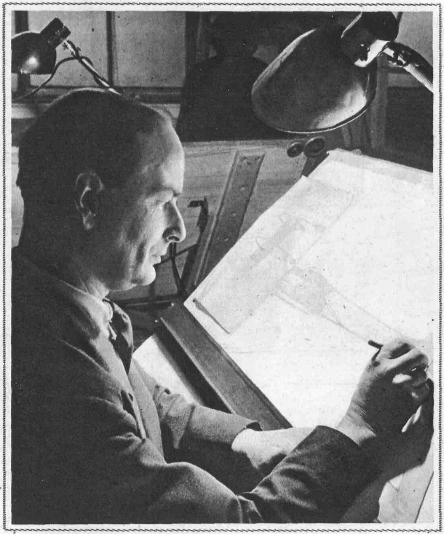
Fabricación de un bombardero "Halifax":
Momentos claves de su producción. Influencia del montaje por partes en el aumento del ritmo de producción.

1. En la mesa de dibujo H. R. Haynes, ingeniero proyectista, trabaja en el diseño del nuevo avión.
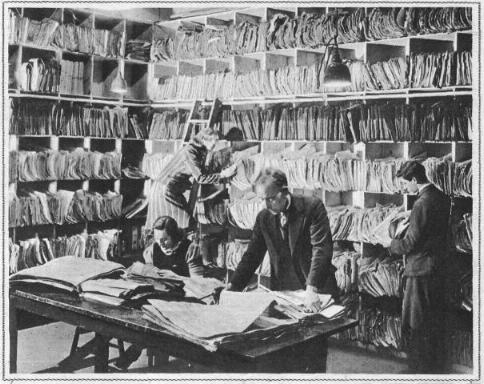
2. A partir de los planos originales se hacen las copias azules. En esta biblioteca del departamento de diseño se consultan y copian unos 4.000 planos diariamente.
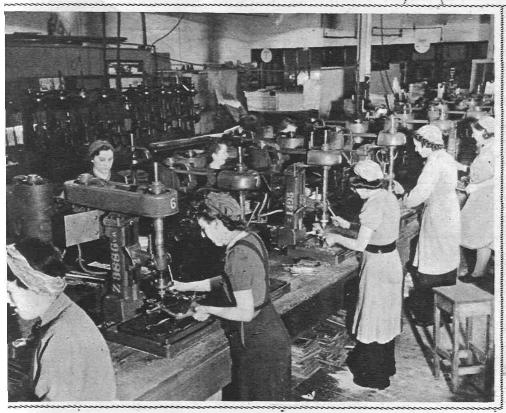
3. Plantillas: Las jovenes obreras taladran las piezas de duraluminio usando modelos guía metálicos.
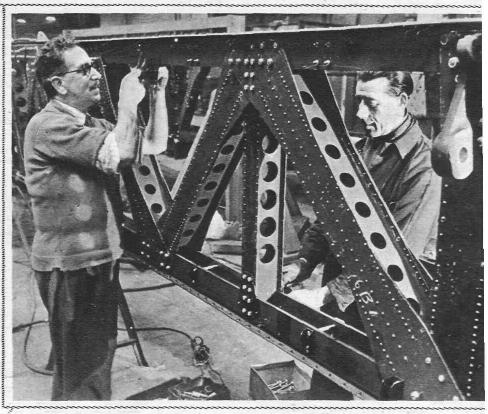
4. Una de las alas va tomando forma. Se trata del larguero delantero del ala que se unirá mediante cuadernas al segundo larguero.
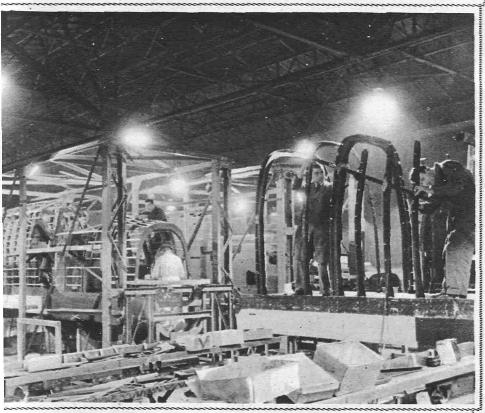
5. A la derecha la parte delantera del fuselaje se comienza a unir sobre los útiles de montaje. A la izquierda ya se puede ver todo el entramado de cuadernas y largueros del mismo.
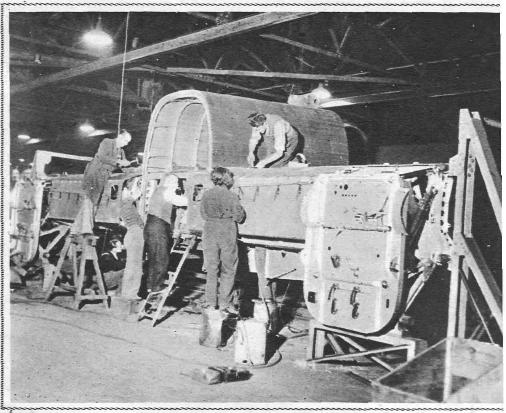
6. Esta parte correspondería a los "hombros" del avión. En la parte delantera se pueden ver los dos mamparos preparados para la instalación de los motores.
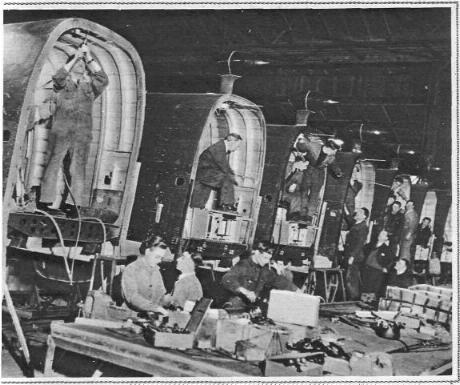
7. La primera operación antes de la unión de los diferentes sectores del fuselaje es el montaje de los innumerables instrumentos con sus cables y todo tipo de elementos esenciales en un avión moderno.
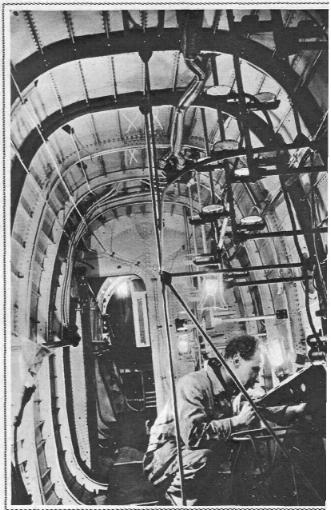
8. Montando una repisa en la parte trasera del fuselaje. Las guías para cargar las bombas y su sistema eléctrico están practicamente acabados.
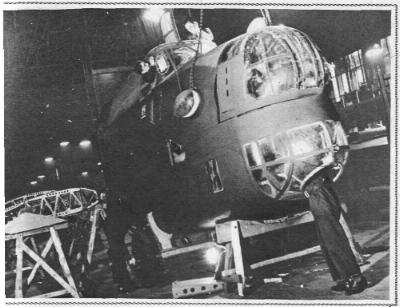
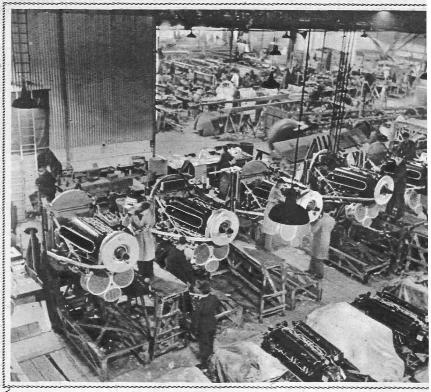
10. Motores Rolls-Royce para propulsar los "Halifax", cada uno desarrolla 1.200 H.P., y el "Halifax" dispone de cuatro de ellos.
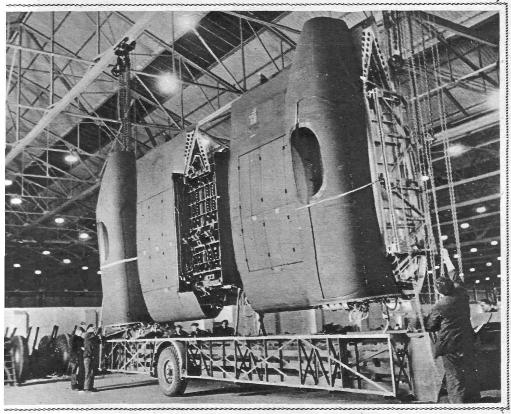
11. La enorme sección central llega al hangar de montaje. A cada lado se encuentran las góndolas vacías y a la izquierda se ve la sección de enlace de los motores de estribor.
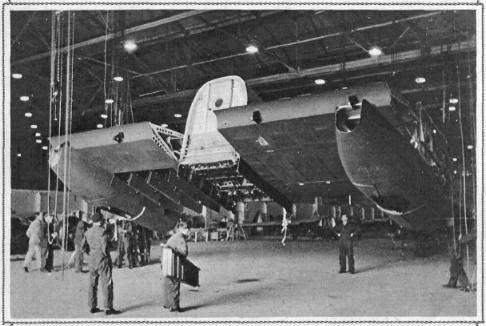
12. Otra vista de la sección central del "Halifax" situandose en posición para el ensamblado con otras secciones, los motores y el tren de aterrizaje.
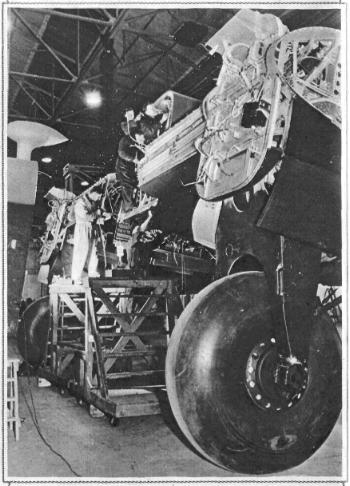
13. El tren de aterrizaje con sus ruedas gigantes está colocado en su posición. Los mamparos están preparados para recibir pronto los motores.
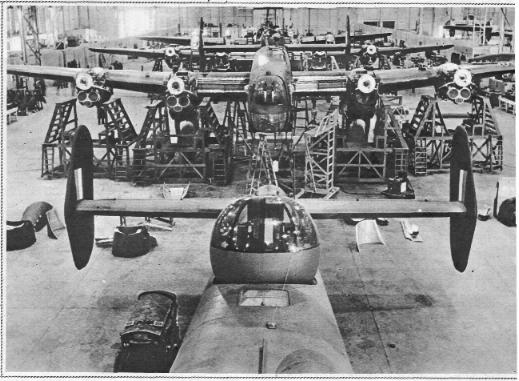
14. Vista general del hangar de montaje. Las alas, la nariz, los motores y la cola se encuentran en su sitio y los aviones se aproximan rápidamente al final de su montaje y a su primer vuelo.

15. El bombardero gigante está completo y las personas que se encuentran de pie bajo sus alas ponen de manifiesto su gran tamaño. Tiene una longitud de alas de 98 pies y 10 pulgadas y 70 pies de longitud de fuselaje. El "Halifax" lleva una tripulación de siete personas y su carga de bombas es muy grande.
"Desde el principio este avión se ha ido produciendo sin grandes modificaciones. La producción se comenzó después de realizados dos prototipos y la primera máquina de serie salió del hangar el 11 de octubre de 1940." Los datos son de un artículo aparecido en la publicación " Aeroplane " dedicado al famoso bombardero cuatrimotor Handley-Page " Halifax ". Este notable avión transporta su carga de bombas a gran distancia, no siendo superado, hoy en día, por ningún otro avión en activo. Nuestras fotografías y sus pies de foto ilustran algunas etapas de la construcción de este poderoso bombardero y hacen especial incapie no tanto en el diseño del " Halifax " sino en la relación entre este diseño y el ritmo de producción. El artículo de la revista " Aeroplane " nos dice : " Desde el punto de vista de la producción quizás el aspecto más interesante del " Halifax " es el sistema de montaje por secciones. Este sistema se desarrolló primero para el " Harrow " en 1936 y también se utilizó en el " Hampden " en 1938. Este método tiene dos grandes virtudes. Primeramente se divide el fuselaje del avión en secciones que faciliten el transporte y la reparación. El trabajo por secciones permite el empleo de muchos más trabajadores en cada fase de la fabricación, aumentando el ritmo de producción. Con esto se consigue un número mayor de unidades producidas diariamente, acortando también el tiempo dedicado a las pruebas de funcionamiento." El periodista explica en su artículo de que manera las secciones se dividen en subsecciones en cuya construcción se realizan simultaneamente la mayor cantidad de operaciones. El ala, por ejemplo, se construye en cinco partes: la sección central —mostrada en dos de nuestras fotografías— incorporan el anclaje para dos de los motores y van unidas con la sección central del fuselaje. Posteriormente se instalan los elementos del tren de aterrizaje. El resto de las alas están formadas por dos secciones cada una. El fuselaje se divide en cinco secciones. La sección más compleja es la nariz que incluye el alojamiento de los miembros de la tripulación, la torreta de ametralladoras frontal movida eléctricamente, el puesto del bombardero y del navegador y los puestos del piloto y el operador de radio, incluyendo también numerosos delicados y complicados equipos de control. La unidad de cola, que incluye dos aletas de timón gemelas, es de construcción cantilever; se construye por separado y se coloca en su posición en el conjunto de la cola. Es interesante recordar que la empresa Handley-Page Company construyó el primer gran bombardero según las especificaciones del Almirantazgo en 1914, desde este primer momento esta compañía se ha situado a la cabeza de los constructores en el desarrollo de grandes aviones de bombardeo. El primer bombardero construido pesaba 8.000 libras : el " Halifax " pesa 60.000 libras. ! En cuanto a su tamaño tiene una longitud de alas de 98 pies y 10 pulgadas y una longitud de fuselaje de 70 pies y 1 pulgada. Disponen de cuatro motores Rolls-Royce " Merlin " que desarrollan cada uno 1.200 h.p., los escuadrones de bombarderos " Halifax " están en servicio operacional desde el final de 1940 y su número se ha ido incrementando.
"The Ilustrated London News", Nº 5.381, Volumen 200The Making of a "Halifax" bomber:
Londres, 6 de junio de 1942, Commonwealth House.
Key stages in production. Simplifies and how the split-assembly system speeds production.

1. The drawing-board, where first a new aeroplane takes form. H. R. Haynes, new designs engineer, at work.

2. Blue-prints are then made from the original drawings. This is the library of the drawing office, which releases 4.000 prints a day.

3. Templates: Girl workers drilling these metal patterns, from which scores of replicas are made in duralumin.

4. A wing begins to take shape. This is the front wing spar being linked by girders to a second spar.

5. On the right the front part of the fuselage is ready for the assembly jig. (Left) A front fuselage already in the jig.

6. The "Head and shoulders" of the aircarft taking shape eight and left are the two bulkheads which will receive the engines.

7. One of the early stages in the fitting of fuselages with the innumerable instruments, wires and so forth which are essential to modern aircraft.

8. Fitting a compass mounting bracket in the rear fuselage. The munition racks are nearing completion, as is the wiring system.

9. The nose of the aircraft has come off the jig. The air-speed indicator and electrical equipment have yet to be fitted.

10. Rolls-Royce engines for fitment to "Halifaxes." each develops 1.200 H.P., and the "Halifax" is a four-engine machine.

11. The huge centre section arrives at the assembly station. On either side are the as yet empty nacelles of the inner port and starboard engines.

12. Another view of the centre section of a "Halifax" showing it being placed in position for the fitment of other sections, engines and undercarriage.

13. The undercarriage, with itsgiant wheels, is now in place. The bulkheads are nearly ready to receive the engines.

14. A general view of the assembly shed, wings, nose, engines and tail are all in position, the aeroplanes are rapidly approaching completion and their first flight.

15. The giant bomber is completed and those standing beneath the wings emphasiseits great size. It has a wing-span of 98 Ft. 10 ins. and it is 70 Ft.long. The "Halifax" carries a crew of seven; its bomb-load is "very heavy".
"From the beginning the aeroplane was right and no major modifications were needed. Production had begun before the two prototypes were finished, and the first production machine flew on October 11, 1940." The quotation is from an article in the " Aeroplane " dealing at considerable length with the already-famous Handley-Page four-engined " Halifax " bomber. This notable aircraft carries a heavier bomb-load over a greater distance than any other aeroplane in the world on active service to-day. Our pictures on this and the following pages illustrate certain stages in the construction of these mighty bombers, and it is a point of especial interest that the " Halifax " designers from the very begining took into most careful consideration not only the design of the craft but its ease and speed of production. To quote the " Aeroplane " again : " From the production viewpoint perhaps the most interesting feature about the " Halifax " is the system of split assembly on which it is built. The system was developed first for the " Harrow " in 1936 and then for the " Hampden " in 1938. It has two great virtues. First it divides the aeroplane into convenient pieces for transport and repair, and secondly, it makes possible the emploiment of more people on each stage of the job, and ence speeds output. In all there are some twenty-four major assemblies, and they are put together and the machine test-flown in an extraordinarily short time after they have been completed." The writer goes on to explain how each of the main assemblies is divided into sub-assemblies, so that construction is divided up among the largest possible number of operatives. The wing, for instance, is built up in five parts: the centre section—as two of our pictures show—carries the mountings for two of the engines, and is assembled with the centre section of the fuselage. Later the undercarriage units are fitted. The outer portions of the wings are divided into two sections. The fuselage is sub-divided into four main assemblies, of which the nose section is the most complex, including as it does accommodation for members of the crew, the front electrically-operated gun turret, bomb-aiming and navigational positions, and places for the pilot and radio operator, both of whom are in charge of numerous delicate and complicated controls. The tail unit, including its twin fins and rudders, is of cantilever construction ; it is built up separately and dropped into position on the tail assembly. It is interesting to recall that it was the Handley-Page Company who built their first heavy bomber in response to an Admiralty specification in 1914, since which time the firm has played a leading part in the development of heavy bomber aircraft. The first service bomber built weighed 8000 lb. : the " Halifax " weighs 60,000 lb. ! As to size, it has a wing-span of 98 ft. 10 ins., and a length of 70 ft. 1 in. Driven by four Rolls-Royce " Merlin " engines, each developing 1200 h.p., the machine—for its size—is very fast, and is stated to carry a " very heavy " bomb-load. " Halifax " squadrons have been on operational service since the end of 1940, and their numbers are steadily increasing.
"The Ilustrated London News", No. 5381, Volume 200
London, June 6 1942, Commonwealth House.